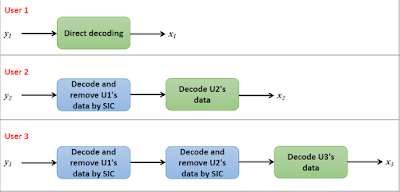Single Carrier NOMA (SC NOMA) - How many users can it support?

We saw how non-orthogonal multiple access (NOMA) can somehow magically break the capacity limitation faced by the other traditional orthogonal multiple access (OMA) schemes. OMA schemes like TDMA, FDMA, CDMA, OFDMA separates the users in time, frequency, code, subcarrier domains respectively. No two users are allowed to share the same resource simultaneously. If this condition is violated, interference would occur and both users would lose their data. For a moment, let's consider an OFDMA network with 64 subcarriers. If we assign one orthogonal subcarrier per user, the maximum number of users we can simultaneously serve is 64. If the 65th user requests a connection, his call must be dropped or he must wait for one of the other users to finish transmitting. This is because we don't have any more orthogonal subcarrier to assign to the new user. This orthogonality bottleneck imposes a capacity limitation on the number of...





